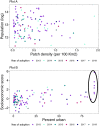Evaluation of the national sobriety checkpoints program in Mexico: a difference-in-difference approach with variation in timing of program adoption
- PMID: 36411475
- PMCID: PMC9680121
- DOI: 10.1186/s40621-022-00407-4
Evaluation of the national sobriety checkpoints program in Mexico: a difference-in-difference approach with variation in timing of program adoption
Abstract
Background: Up to a third of global road traffic deaths, and one in five in Mexico, are attributable to alcohol. In 2013, Mexico launched a national sobriety checkpoints program designed to reduce drink-driving in municipalities with high rates of alcohol-related collisions. Our study measured the association between the sobriety checkpoints program and road traffic mortality rates in 106 urban municipalities.
Methods: We leveraged data from the Salud Urbana en America Latina (SALURBAL), which compiles health and environmental data from cities with over 100,000 residents. Death data from 2005 to 2019 (i.e., outcome) were from official vital statistics. Among 106 Mexican municipalities defined as priority areas for intervention, 54 adopted the program (i.e., treatment) in 2013, 16 municipalities did so in 2014, 16 in 2015, 10 in 2016, 7 in 2017, and 2 in 2019. We used a difference-in-difference approach with inverse probability weighting adapted to a context where program adoption is staggered over time.
Results: There was a 12.3% reduction in road traffic fatalities per 10,000 passenger vehicles in the post-treatment period compared to the pre-treatment period (95% Confidence Interval, - 17.8; - 6,5). There was a clear trend of decline in mortality in municipalities that adopted the program (vs. comparison) particularly after year 2 of the program.
Conclusions: In this study of 106 municipalities in Mexico, we found a 12.3% reduction in traffic fatalities associated with the adoption of sobriety checkpoints. There was a clear trend indicating that this association increased over time, which is consistent with sustained changes in drink-driving behavior. These findings provide support and insight for efforts to implement and evaluate the impact of sobriety checkpoint policies across Latin America.
Keywords: Alcohol control policy; Alcohol-related harm; Drink-driving policies; Latin America; Mexico; Road traffic deaths.
© 2022. The Author(s).
Conflict of interest statement
The authors declare no conflict of interest.
Figures



References
-
- Andreuccetti G, Carvalho HB, Cherpitel CJ, et al. Reducing the legal blood alcohol concentration limit for driving in developing countries: a time for change? Results and implications derived from a time–series analysis (2001–10) conducted in Brazil. Addiction. 2011;106(12):2124–2131. doi: 10.1111/j.1360-0443.2011.03521.x. - DOI - PMC - PubMed
-
- Athey S, Imbens GW. Design-based analysis in difference-in-differences settings with staggered adoption. J Econom. 2021 doi: 10.1016/j.jeconom.2020.10.012. - DOI
Grants and funding
LinkOut - more resources
Full Text Sources
Research Materials

